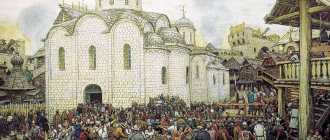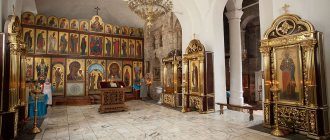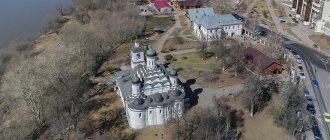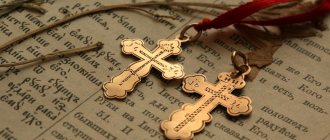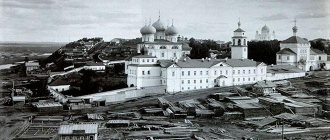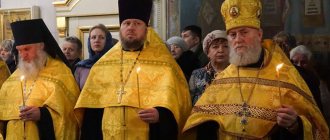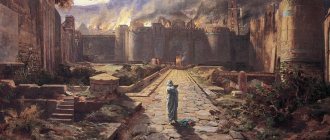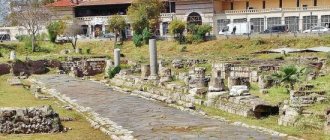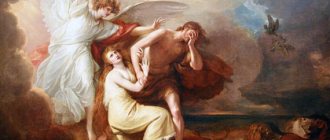- Home page
- •
- Directory of Church Terms
- •
- Worship cross
Worship crosses
, as a rule, are placed outside churches - in order to remind people of God and encourage them to pray. Usually these are quite tall structures visible from afar. The worship cross can be wooden, stone, metal. It can be a genuine monument of art - for example, stone carving, or it can be quite simple - two wooden crossbars.
According to legend, the Apostle Andrew
, having arrived at the site of the future Kyiv, he placed a cross on a high hill above the Dnieper. It turns out that this was the first worship cross in Rus'. Perhaps this is just a beautiful legend: modern science believes that the first Christians did not depict the cross, since crucifixion was still practiced in their time, and the sight of the instrument of terrible execution was too difficult to perceive. But... science tends to change its conclusions when it receives new data. Be that as it may, worship crosses have been erected in Rus', Greece, and other Orthodox countries since ancient times. The foundation of cities and villages began with them. They were placed at the sites of important historical events. They consecrated the place intended for the construction of the temple. Crosses are placed at crossroads to sanctify the path. Nowadays, they often mark especially dangerous turns, asking the Creator to prevent accidents, and calling drivers to prayer and caution.
Worship cross symbol of the Heavenly Kingdom
The eight endings on the cross mark an equal number of major historical stages in the development of all mankind. The eighth is the life of the next century, the Kingdom of Heaven. The end pointing upward symbolizes the path to this Kingdom opened by Jesus Christ. The beveled crossbar speaks of a broken balance after the coming of the Son of God for all those who are mired in sin. A new stage in the spiritual renewal of humanity has begun, a way out of darkness into light. The oblique crossbar reflects precisely this movement.
Seven-pointed cross
The seven endings on the cross with one upper crossbar and a beveled foot have a rather deep mystical meaning. Even before the appearance of Jesus Christ, clergy offered sacrifice on a golden pedestal attached to the consecrated throne. For example, as it happens among Christians today, through anointing.
Therefore, the footstool under the cross symbolizes the altar of the New Testament. Such similarity mystically points to the sacred action of the Savior, who consciously paid with his torment and death for human sins. A worship cross, consisting of seven ends, is usually found on icons of northern writing; similar symbols in Russia were often installed on domes.
Birth of a symbol
Despite the vivid doctrinal symbolism, early Christians avoided using graphic images of the cross as a symbol of their faith, since the practice of these terrible executions continued until the 4th century, when Christianity became the official religion of the Roman Empire. However, after the middle of the 2nd century, the practice of venerating the Cross of Christ, including liturgical ones, appeared in Christian communities. The first evidence of this is from Marcus Minucius Felix, who at the turn of the 2nd and 3rd centuries. says that enemies accuse Christians of venerating the “tree of the cross.” Tertullian in 204 mentions that Christians regularly place the sign of the cross on their foreheads during the day under various circumstances. However, widespread liturgical veneration of the Cross arose after the first quarter of the 4th century - after the acquisition of the Cross of Christ by the Holy Empress Helen.
An image of the so-called “simple” or “Greek cross” (with all the crossbars the same length, +), was found in the Roman catacombs of the early 3rd century. In the period before the 4th century, images of an anchor as a symbol of hope were widely used in the catacombs, including with a crossbar clearly reminiscent of a cross. The earliest images of the “Latin” cross (†) were found on Roman sarcophagi of noble Christians in the mid and late 4th century AD. A large number of different images of the Christian cross appear on monumental monuments from the 5th century. Crosses with the figure of the Savior on them have been known since the end of the 6th century. In parallel with the liturgical veneration of the Cross, the wearing of body crosses also arose by the 4th century. Chronologically, the first mention of this dates back to the end of this century and is found in one of the conversations of St. John Chrysostom.
*Certificates prepared by Rev. Dimitry Yurevich, vice-rector of the St. Petersburg Theological Academy for scientific work. - Ed. Illustrations from the book “The Cross in Russia”, publishing house “Danilovsky Blagovestnik”, 2006
https://www.foma.ru/poklonnyie-krestyi-v-rossii-istoriya-voprosa.html
Crosses for the grave with your own hands: calculation of proportions, measurements
At the same time, you will develop a design concept and lay out the required dimensions of the product. They are calculated in accordance with the proportions of the “golden ratio”, characteristic of the ideal human body.
This tradition comes from ancient times. Such was the cross of the Savior on which he was crucified.
Dimensions If we take the value of 1.618 m as the base height of the cross, then further relationships should have the following form: - the length of the central crossbar will be equal to 1.618 m; - the distance from it to the top, as well as the length of the top bar will be 0.382 m; — the top crossbar should be 0.236 m from the middle one; - from the top to the first short crossbar the distance is calculated at 0.146 m; - between the lower braid and the base you need to measure 0.5 m. Only after careful measurements and calculations, as well as subsequent accurate drawing of the sketch, begin to create a layout, according to which you can subsequently begin making the cross itself.
At the head
The custom of placing a crucifix behind the head of the deceased is more often followed by Orthodox Christians who live in Western or Central Europe. In their opinion, this arrangement symbolizes the victory of the Son of God over the devil. At the moment of Judgment Day, the cross will become a banner for the deceased, which he will carry after his resurrection. It will indicate the triumph of good over dark forces and will serve as a weapon in the fight against Satan.
What is a crucifix?*
A cross erected by Tsar Peter the Great in 1694 in Unskaya Bay of the White Sea in memory of his miraculous rescue during a severe storm.
This king made the cross with his own hands and brought it to the shore himself. This cross stood for only a few decades, then it was moved to the Pertominsky Monastery, and later to the Holy Trinity Cathedral in Arkhangelsk. Now it is kept in the Arkhangelsk Museum of Local Lore. When the cross was moved, an exact copy was made and installed in the same place. For centuries, local residents looked after this cross, and if it rotted, it was repaired. This is an example when a memorial cross turned out to be a venerable one. The crucifixion, used by the Romans during the time of Christ the Savior, was not just a painful execution, but also a means of intimidation and psychological influence of the Roman authorities on the local population of the provinces. This practice dates back to the ancient Eastern tradition of public executions.
The crucifix began to be often used in the provinces of the Roman Empire (citizens of Rome were executed by beheading with a sword). The Romans perfected Eastern execution techniques to inflict even more pain and humiliation on the victim. To do this, they began to crucify on crosses of two forms - the so-called “Latin cross” (known to us from the example of the Cross of Christ, †) and the “tau cross” (in the form of the letter T). Both of them consisted of a vertical post and a horizontal crossbar (patibulum). The person crucified on the Latin cross was placed on a vertical beam and the entire structure was raised; the person crucified on the tau cross was raised together with the patibulum and placed on a previously installed vertical stand. Hands and feet were fixed with ropes or pierced with iron nails or wooden stakes (hands - near the wrists, not the palms, so that the nails would not break through the tissue and the body would not fall off the cross). The feet rested on a stand and were also nailed down. The suffering of someone executed on the cross could last from 3-4 hours to 3-4 days. In 1968, a fragment of a heel bone with a nail stuck in it was found in a tomb on Mount Scopus in Jerusalem. Research showed that the original length of the nail was 17 cm, and the man's shins were broken.
How the tradition began
The Truvorov cross of the 14th-15th centuries, white stone, is located on the outskirts of the ancient cemetery in Izborsk, next to the so-called Truvorov settlement. Local legend says that this cross marks the grave of Truvor, the legendary Varangian prince who died, according to chronicles, in 864. The height of its ground part is more than 2 meters.
The tradition of putting up crosses arose in Rus' even before its baptism in 988. According to the “Tale of Bygone Years” by Saint Nestor the Chronicler, the holy Equal-to-the-Apostles Princess Olga “began to destroy the temples and idols and began to erect the crosses of Christ in those places; The crosses of Christ continue to work signs and wonders to this day, where the saint placed them.” Equal to the Apostles Prince Vladimir also followed the tradition of erecting crosses. Crosses were installed at the founding site of a city, church, monastery, or fortress - this testified to the consecration of the place and the request from the Lord for blessings to begin construction.
As for the origin of this tradition, then, apparently, it came to Rus' from the Czech Republic and Moravia, where Saints Cyril and Methodius preached. In general, I note that the tradition of erecting memorial crosses is common to all of Eastern Europe - both Orthodox and Catholics. The forms of the cross differ, but the motivation is the same: asking the Lord for protection, thanking Him for his help and calling on people to remember God once again. In Rus', the tradition of putting up crosses was most developed in the North, on the coast of the White Sea. Apparently, because in the Middle Ages it was an outpost of Orthodoxy, the Russian people developed these spaces in a struggle with both difficult natural conditions and the pagan culture of the autochthonous peoples of the North. According to P.V. Boyarsky, there was a “war of religious symbols” - crosses were erected where idols had previously stood.
In addition, if by Russia we mean precisely the world of Russian Orthodox culture, and not the Russian Federation within its current borders, then one cannot help but say about Ukraine. There, the tradition of erecting crosses, especially roadside ones, has always been extremely popular, and, by the way, local residents show more respect for such crosses than many of our compatriots.
Hint for travelers
Conspicuous crosses were intended as a guide for sailors, so their height reached 12 meters. In Ancient Novgorod, the installation of such worship symbols marked the beginning of the Pomeranian custom. Most likely, nowhere in Russia were such a number of crosses erected as in the coastal zone near the White Sea.
The descendants of the Novgorodians, who settled in this area in the 8th-9th centuries, preserved many of the proportions of the worship cross, as well as the traditions and beliefs of pre-Mongol Russia. Usually these products were made of wood, because it lasts a long time in the north side. The cross was erected as a landmark on visible islands, capes, and fishing spots.
At my feet
The installation of a monument at the feet is not considered church law and rather refers to religious traditions, which are not obligatory to follow. However, in most cases it is placed at the foot of the bed so that the structure faces the face of the deceased. There are several interpretations of why Orthodox Christians do this:
- Thanks to this arrangement, the deceased can look at the cross through the rays of the rising sun and offer prayers to the Lord.
- In Orthodoxy, the crucifix is a symbol of eternity. It is believed that sooner or later the day of resurrection will come, and the risen dead will be the first to see the sacred symbol of the Sign of the Cross.
- There is a belief that after the resurrection, the crucifix will serve as a support for the dead, that is, when they get up, they will be able to lean on it.
- Many believers believe that before the Last Judgment, Jesus will appear to people from the eastern side, and the deceased will be the first to see him against the backdrop of the cross.
Be that as it may, the cross in the Orthodox religion is a source of light and faith, and the traditions of its installation are always honored and observed.
Types of crosses
Worship crosses
They were placed outside churches to remind believers of Christ.
Votive crosses
They were placed by people as a vow, as a sign of gratitude to God for help in trouble, for miraculous salvation.
Security crosses
They were placed as spiritual protection from evil spirits, from diseases, from any misfortune.
Memorial crosses
They were placed as a sign of memory of some significant event, at the sites of battles, at the sites of death - in order to call for prayer for them.
The division of crosses into types is quite arbitrary. Often the installed cross turned out to be a memorial, a worship, a security cross, and also served non-religious purposes.
Twists of tradition
Lopastitskoye Cross Installed in the 12th century on the bank of the channel from Lake Lopastitskoye to Lake Vitbino. It was carved out of white stone, with an image of the Rurikovich sign of the Vladimir princely house carved on it. It apparently marked the beginning of the safe Vitba trade route laid by the Novgorodians and was erected when a canal was dug between the lakes. This is at the same time a protective, boundary, and memorial sign.
In the old days, people had great respect for crosses that had already been put up. As an example, we can cite the story of the cross erected by Tsar Peter the Great. Local residents have been updating this cross for many generations - completely independently, without any coercion from secular or ecclesiastical authorities.
Nowadays they sometimes doubt: did our ancestors understand the inscriptions on such crosses? After all, they were supposedly illiterate. Here we can answer that there is no need to exaggerate illiteracy. There were quite a lot of literate people in Rus', including among peasants, and such a problem - the inability to read the inscription on the cross - simply did not exist. There would always be those who would read and explain what was written. Another thing is that the inscriptions on crosses, especially wooden ones, could become difficult to discern over several centuries - wood inevitably deteriorates in the open air. But in any case, there was also an oral tradition: the old people told the children what kind of cross stood near their village, who erected it, and what was written there. Of course, these stories could over time acquire folklore elements, but the basis remained unchanged.
Well, as for the general attitude, it was reverent. Crosses were perceived as a sign of God's presence here in a given area, as a reminder of faith. People gathered near the crosses and held prayer services, especially where there were no churches nearby. Whether there were cases of neglect, or even more so of sacrilege, I cannot say; I have not come across such information. Of course, I’m not talking about the 20th century now, but about older times. But in the twentieth century, the fate of the crosses was difficult. The Soviet government did not spare the churches, let alone the “symbols of religious obscurantism” standing outside the churches. Crosses were destroyed by militant atheists. Let me give you a few quotes again. “The most famous northern scientist, an honorary resident of the city of Arkhangelsk, Ksenia Petrovna Gemp (1894-1998), says in her memoirs: “... I remember how on the square in front of the Trinity Cathedral, young people, singing and dancing, burned a cross at the stake. No, not a church cross, but an identification cross, carved and installed by Peter the Great on Red Mountain, at the mouth of the Unskaya Bay." (I quote the work of V. N. Abramovsky “Two Notes on Historical Crosses”. It is not known whether this was really the cross of Peter the Great or a copy of it (here the researchers did not agree), but what does this change! The second quote is from the already mentioned work of P V. Boyarsky “And on almost every cape of Matveev Island we discovered the remains of Pomeranian crosses in 1991. For some reason they interfered with the builders of geodetic signs and active atheists so much that they were cut down, cut down, or at best used as a reliable “load-bearing structure.” "triangulation signs".
Svyatoslav cross of 1234 According to legend, the noble prince Svyatoslav Vsevolodovich carved it out of stone in memory of his miraculous salvation during a strong storm that struck his boats returning after a victorious campaign against the Volga Bulgars in 1220. Now this cross is kept in the St. George Cathedral in the city of Yuryev-Polsky, Vladimir region and is revered as miraculous.
As a result, the tradition of installing crosses was practically interrupted for several decades. Although not immediately. Yes, from the very first days of its existence, the Soviet government declared war on crosses - but for the time being they continued to erect crosses, albeit not for religious purposes. Thus, in the 1920s, scientific expeditions exploring Novaya Zemlya erected four-pointed crosses as a sign of their presence there. That is, we note that the goals are no longer religious, but the form is still the same. It is clear that in Stalin’s times one could pay with one’s life for installing a worship cross, and such a cross would not have lasted long. I don’t know whether there were such cases, but it cannot be completely ruled out.
In post-Soviet times, the tradition of erecting crosses was restored. Sometimes they ask how these modern crosses differ from the ancient ones. If we talk about technologies and materials - yes, of course, there may be differences, especially with regard to metal crosses. Wooden ones are more traditional. Well, as for the motivation for their installation, we can only state that seriously believing Orthodox people have the same motivation as centuries ago. I can imagine that now the “security” motivation, that is, protection from evil spirits, is receding into the background, and gratitude to God for His mercy and reminding Christians of their faith come first.
INTERESTING:
For what purpose are worship crosses installed?
Ancient ascetics, when they came to a deserted place, put a wooden cross there - thereby sanctifying this desert, testifying to the grace of God and casting out demons. This is known from many lives of Russian saints. In addition, the worship cross could be a sign of spiritual war against paganism, as was the case, for example, in the North of Rus'.
However, crosses were erected not only by holy ascetics, but also by ordinary people from different classes - from kings to serfs. Crosses were erected, for example, for worship in places where there were no temples or chapels. Local residents gathered at such crosses and prayed to God; such crosses reminded travelers of God.
Often worship crosses are installed on the site of a destroyed or future temple and are its kind of substitute in marking sacred space.
Security crosses were also placed - in fact, such crosses were the visible embodiment of a prayer to the Lord for deliverance from all evil. Crosses were also placed on personal vows - say, in gratitude for healing, on the occasion of deliverance from misfortunes, at the site of the death of Christians, for deliverance from a pestilence, for salvation from death.
But there were also non-religious purposes for installing crosses - for orientation on the ground. For example, multi-meter (up to 10 meters in height) noticeable crosses located along the shores of the White Sea were a kind of lighthouses, navigational signs, showing sailors the way to the saving harbor. But this was not only in the North. Crosses were also placed along river banks as landmarks and boundary signs. For example, the Sterzhensky and Lopastitsky crosses of the 12th century, now they are in the Tver State United Museum-Reserve. These stone crosses are at the same time protective, boundary, and memorial signs.
Question and answer
Is it possible to order a monument in the shape of a cross through City Ritual Service LLC?
Yes, we will help you choose the appropriate option and place your order. Phone +375 (44) 782 97 76 works around the clock.
How much does a stationary granite cross for a grave cost?
Such monuments made of natural granite cost from seven hundred rubles.
What metal is best to order a permanent cross for a burial plot?
It can be stainless steel or cast iron. Nowadays, figure casting from cast iron is experiencing a revival. True, such a cross must be ordered in Russia.
How the Worship Crosses were Erected
The installation of such crosses in ancient times was a special ritual, which was approached with all seriousness, responsibility and respect. Usually, people gathered as a whole village to perform this ritual.
You probably saw that the Worship crosses stand on a small hill (a symbol of Golgotha), and so, in order to create such an elevation, each villager brought a handful of earth and placed it on the site of the future foot of the cross.
Traditionally, such crosses were made of wood, less often of stone and very rarely of metal. When installing, they were guided by the cardinal directions: the flat part of the cross faced east, and the raised end of the lower crossbar faced north.
What prayer rules are usually performed near worship crosses?
Crosses have always been perceived as a sign of God's presence here in a given area, as a reminder of faith. Therefore, people gathered near the crosses, they held prayer services or memorial services - especially where there were no churches nearby. In the absence of a clergyman, believers performed (and often still do) reading canons and akathists. And, for example, some Valaam pilgrims and workers have a tradition of reading the morning and evening rules, canons and the Follow-up to Holy Communion at the worship crosses.
Based on materials: articles by E.M. Gureev “Worship crosses of the Russian North of the 16th–17th centuries: a review of domestic historiography”; articles by P.V. Boyarsky “Russian cross in the sacred space of the Arctic”; articles “Worship crosses in Russia: history of the issue” / Orthodox magazine FOMA; free encyclopedia Wikipedia; open sources.
Source
